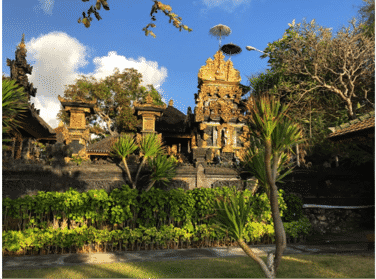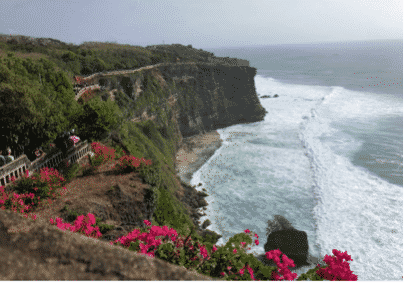
Does anyone remember the musical “South Pacific?” I’m sure there are some that do. It was one of my favorites, as a child. I certainly never imagined I would have the opportunity to experience “Bali Hai—is calling…where the sky meets the sea. A special island.” Fortunately, due to my husband’s speaking engagements with the International Institute of Welding, I found myself in the South Pacific, “where the skies meet the sea.” I would like to share some of my impressions as we explored this beautiful island. I also would like to request prayers for the safety and recovery of the wonderful people in those islands that experienced the earthquakes this past summer. Everywhere we toured were signs for “Tsunami Evacuation Route” and directions to get to the highest hotel floor or tallest area for safety.
Beauty of Bali
Aside from the threat of earthquakes and tsunami waves that they have lived fearing for years, the beauty is magnificent. Bali is just one of many Indonesian Islands in the Indian Ocean and the Bali Sea. White beaches, tropical palm trees, Hindu temples on every corner, and friendly people abound. We had the opportunity to stay in some beautiful hotels, the first was the Nusa Dua Hotel and Spa, the oldest on the island. They had planted trees and palms to shade the beach for the preservation of natural beauty rather than umbrellas over the chairs for shade. The bottled water, which was all that we drank due to the lack of sanitation services on the island, was in glass bottles (see photo above) very colorfully decorated with flowers typical of the scenery. The flowers were magnificent in the hotels and along the streets. Many begonia and tropical flowers. One of the hotels that we stayed in had a jungle-like atmosphere with a swim-up pool and steps going onto the patio and the room, surrounded by beautiful trees and plants.
Economics in Bali
The country is stricken with poverty, as are many countries outside the United States. The average salary for one month’s work in Bali is about 200 American dollars with the average rent of a two-bedroom apartment being around $50. Some people work for the hotels or drive taxi cabs for a living, such as the young man who took us on a full day tour in a nice vehicle (similar to Uber) only charging us $55 and would not accept a gratuity. The people seem to appreciate the positive aspects of their life, not focusing on the things they don’t have. We were continually impressed with the spirituality and kindness of the Balinese people, as well as the noted lean-ness of the people. We, in the bountiful USA, could take some lessons.
 A Foundation of Faith and Family
A Foundation of Faith and Family
In talking with the native Balinese, it seemed obvious that their faith and family were uppermost in their lives. The Balinese do have minorities of Christian, Muslin, and Buddist religions, but primarily most of the Balinese people practice Hinduism. Balinese Hinduism, called Agama Hindu Dharma, originated from Java and Shivaism and Buddism. It’s a combination of Indian philosophy with indigenous Balinese beliefs that nature is “power” and each element is subject to influence from the spirits. Ancestor worship is common while spirits and ancestors are treated with respect. They are housed in a shrine and given “offerings” made from agricultural products, such as rice and flowers. Each home, each place of business, often cars, and certainly temples will have “offerings” in front of them as you walk along. They are little boxes made of bamboo with objects “offered” to the spirits and Gods for protection against evil. Hinduism is built on five pillars of faith: a Supreme God; belief in the soul as the universal principle of life; belief in the fruition of one’s deeds (giving and helping others), and belief in the ultimate release (moksa—like heaven). The community revolves around family and religion. The family worships common ancestors in the family shrine of each household. Temples are built inside homes, as well as in the community. It is not uncommon to see temples in the middle of a home or just in the middle of a business area. The family “compound” is bordered by brick or a fence to protect the family from dangerous “influences.” The children are taught family household chores and religious practices. Often outside the compound is a fruit garden. We also saw very few “homeless” people on the streets as you see in America. Gede, our guide, said it is because the government goes into homes to evaluate if the family needs help with food, shelter, or schools. Then they are given the help they need and help to find a job. They try to “take care of one another,” he explained. Again, going along with the necessary foundation focusing on family and religion, taught in homes throughout the country. Probably a reason that crime is so low in Bali, as well.
There are many statues and symbols of their “Gods” who are protecting them from evil spirits. In the temples, one of the Hindu faith only would enter the temple to find “balance” and leave from an exit door with positive feelings, leaving evil spirits behind. Rice is applied to their foreheads after one prays to give “positive energy” to your soul. The Balinese offer prayer three times daily for protection, asking for a good day and good fortune.
Balinese Culture and Employment
Most of the Balinese still work in the agricultural sector which includes wet and dry rice fields, cattle and poultry farming, and fisheries. They work communally organizing themselves from planting time to harvesting in their small communities. Their work is labor-intense, and their food is primarily vegetables, rice, and fish. We were impressed by the lean-ness of society. It was very rare to see anyone from Bali that was overweight or considered obese. Their culture promotes a more active lifestyle, often out of necessity, as well as lean, healthy foods in the vegetables and “sticky rice” being staples, as well as fish and chicken. I saw a book entitled, Food and Life, The Art of Nourishment, by Dr. Nadia Volf, which I felt conveyed their spirit of nourishment, so obvious in the people. “All our life is thus exalted by the magic power of art—for each of our five senses, man has created art. For the taste buds and taste, cookery—the art of preparing foods offered by nature. Art that bears us off into dreams, allows us to touch everyday beauties, insists unceasingly on the simple happiness of existing, and wakes in us infinite, previously unimagined possibilities.” The buffets that we enjoyed were often multi-cultural with cuisine from China, Japan, India, Bali, and Western.
We met a young man who took us around the island for several days, and when asked about their religion and culture, he replied: “Everybody tries to be friendly. We know we have one life and want to do good. We want to be happy with family and friends. That is the way in Bali. Try not to get angry, but be patient with one another. Helps protect us from evil spirits.” A philosophy I will never forget…
Happy, healthy holidays to you,
Terry Polanin, MSN, APN
Family Nurse Practitioner
